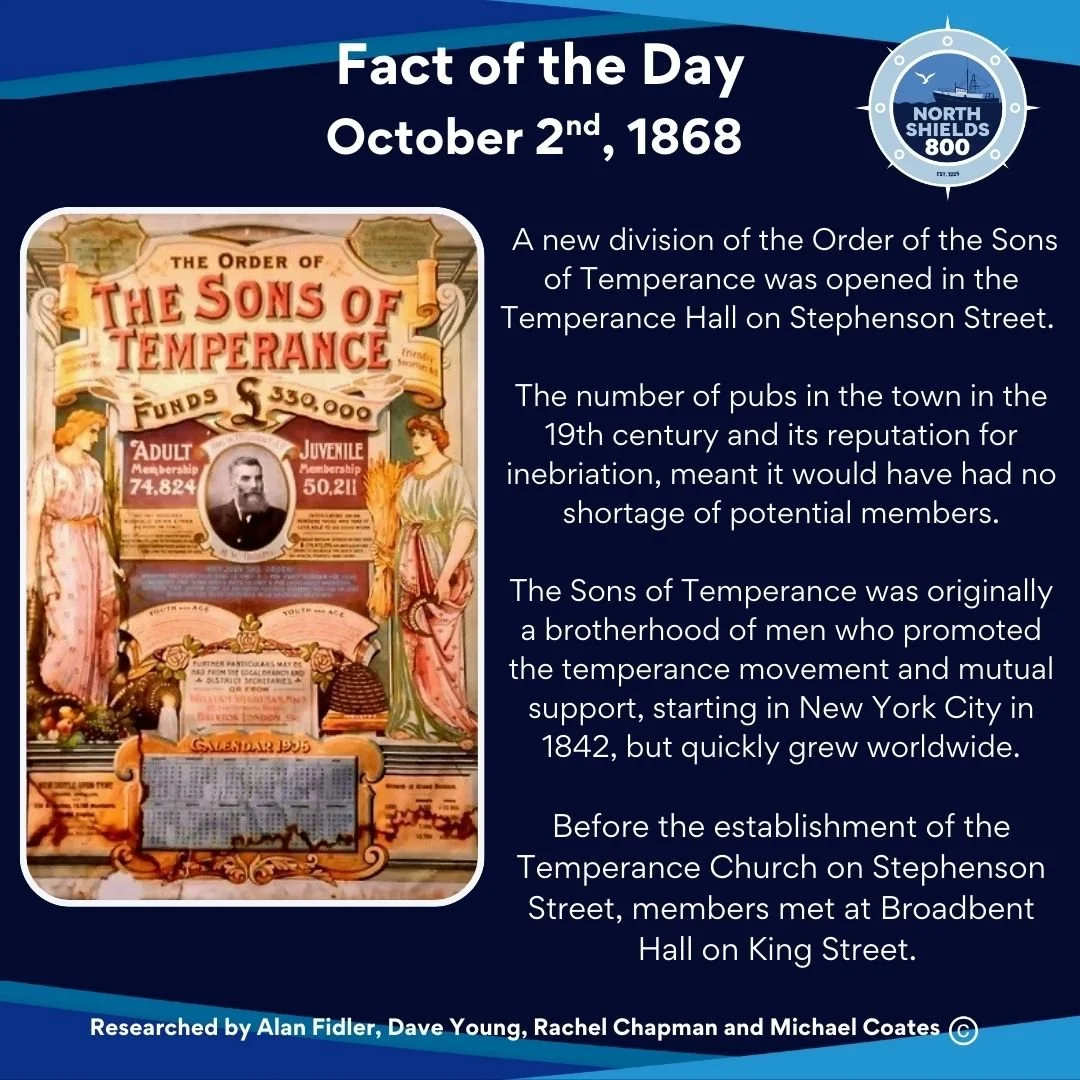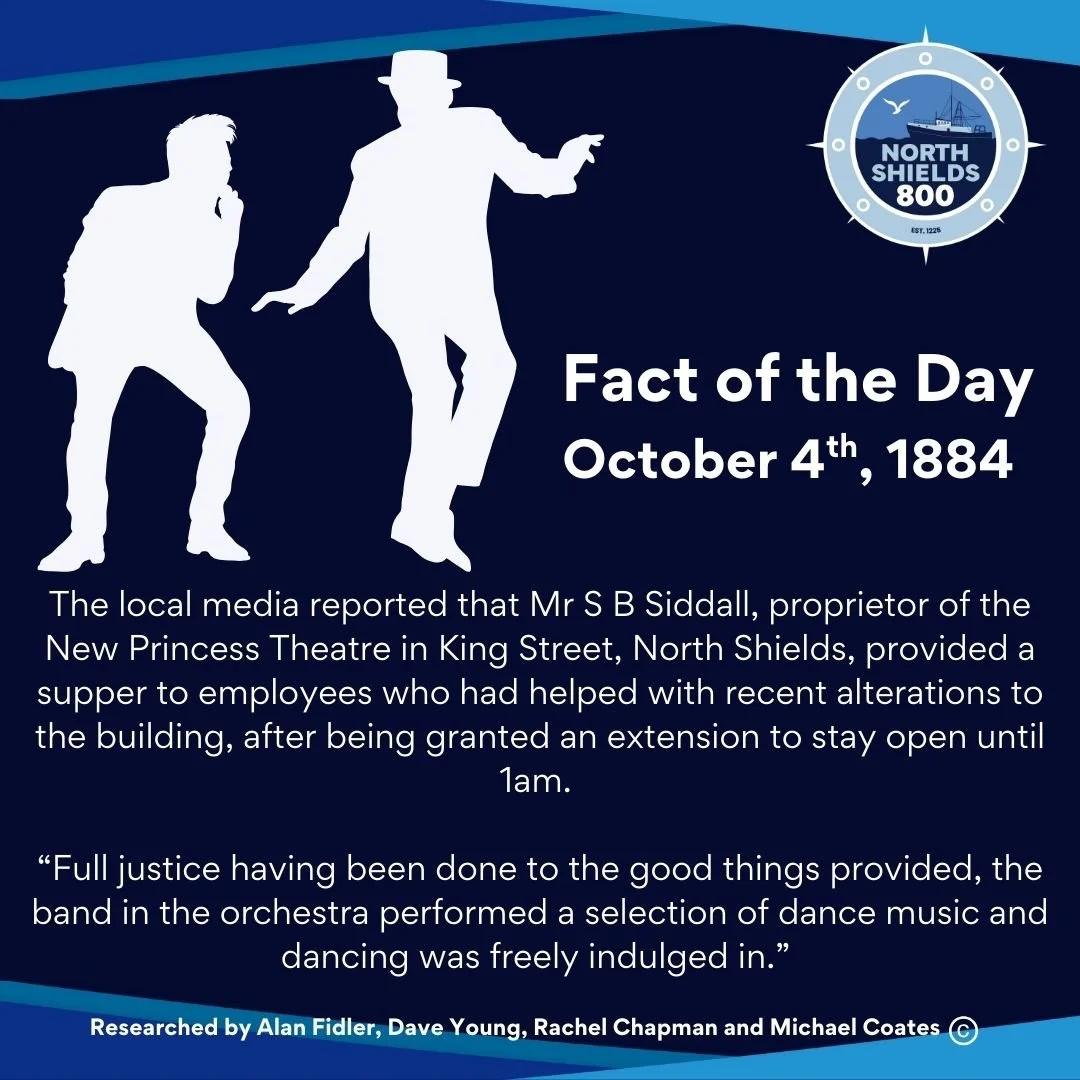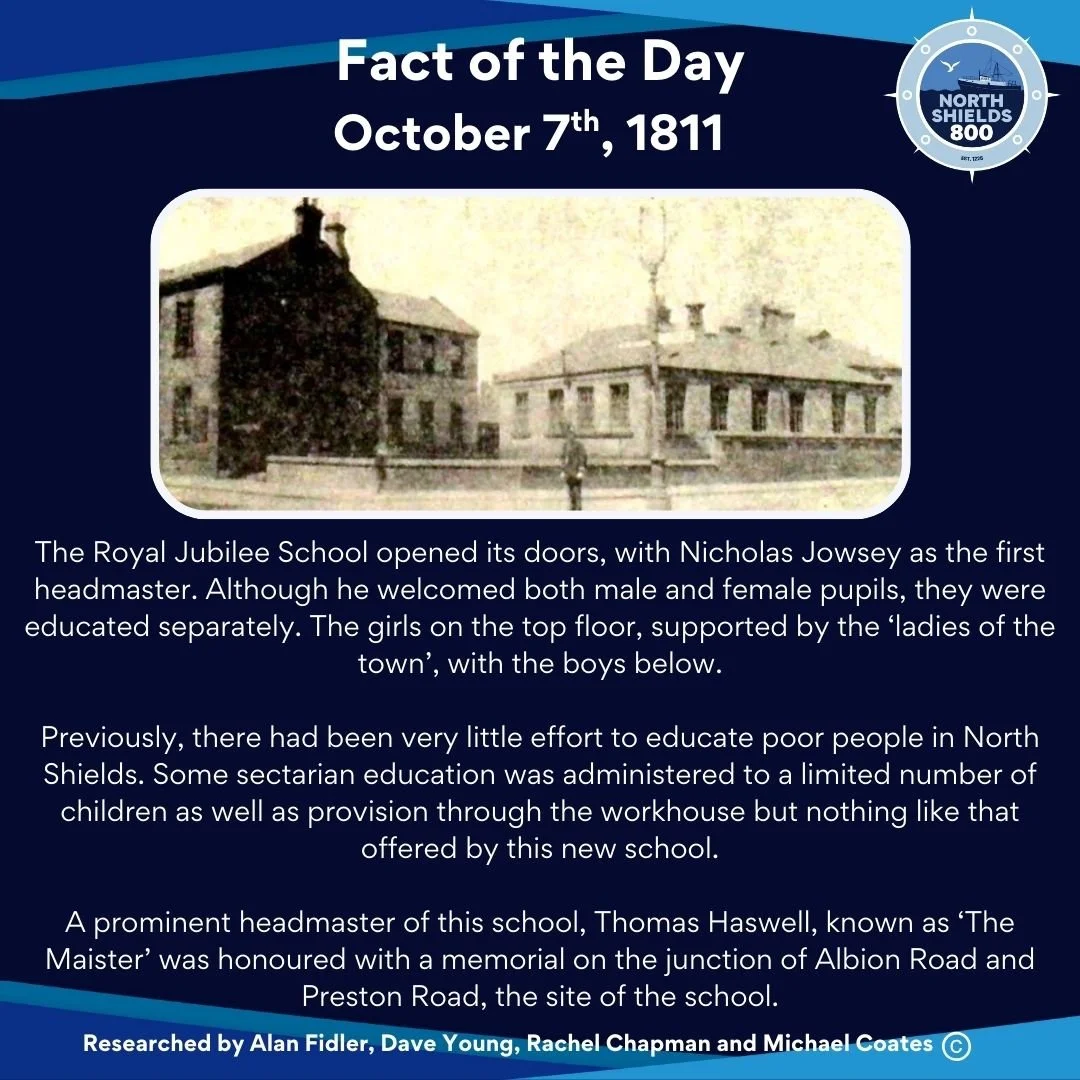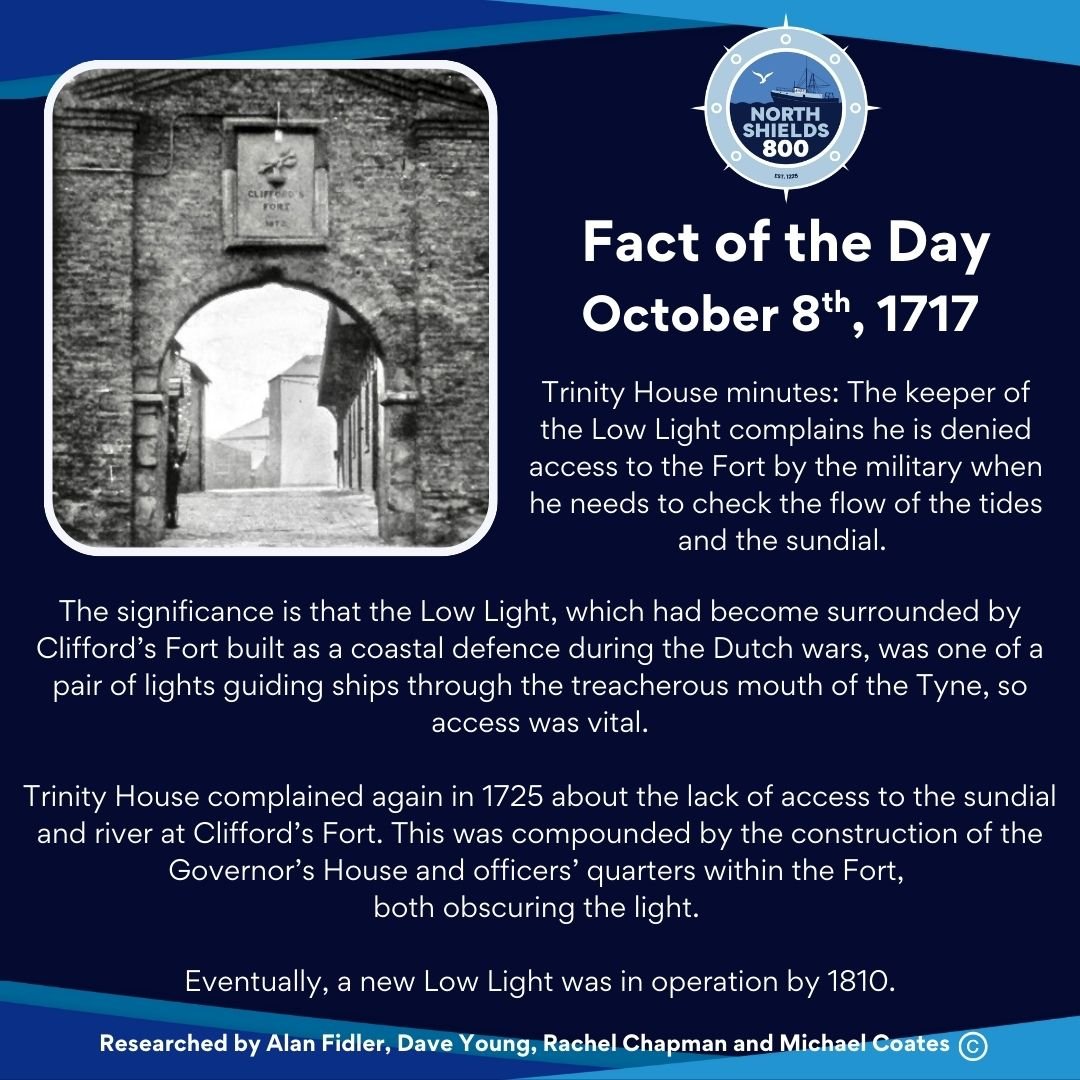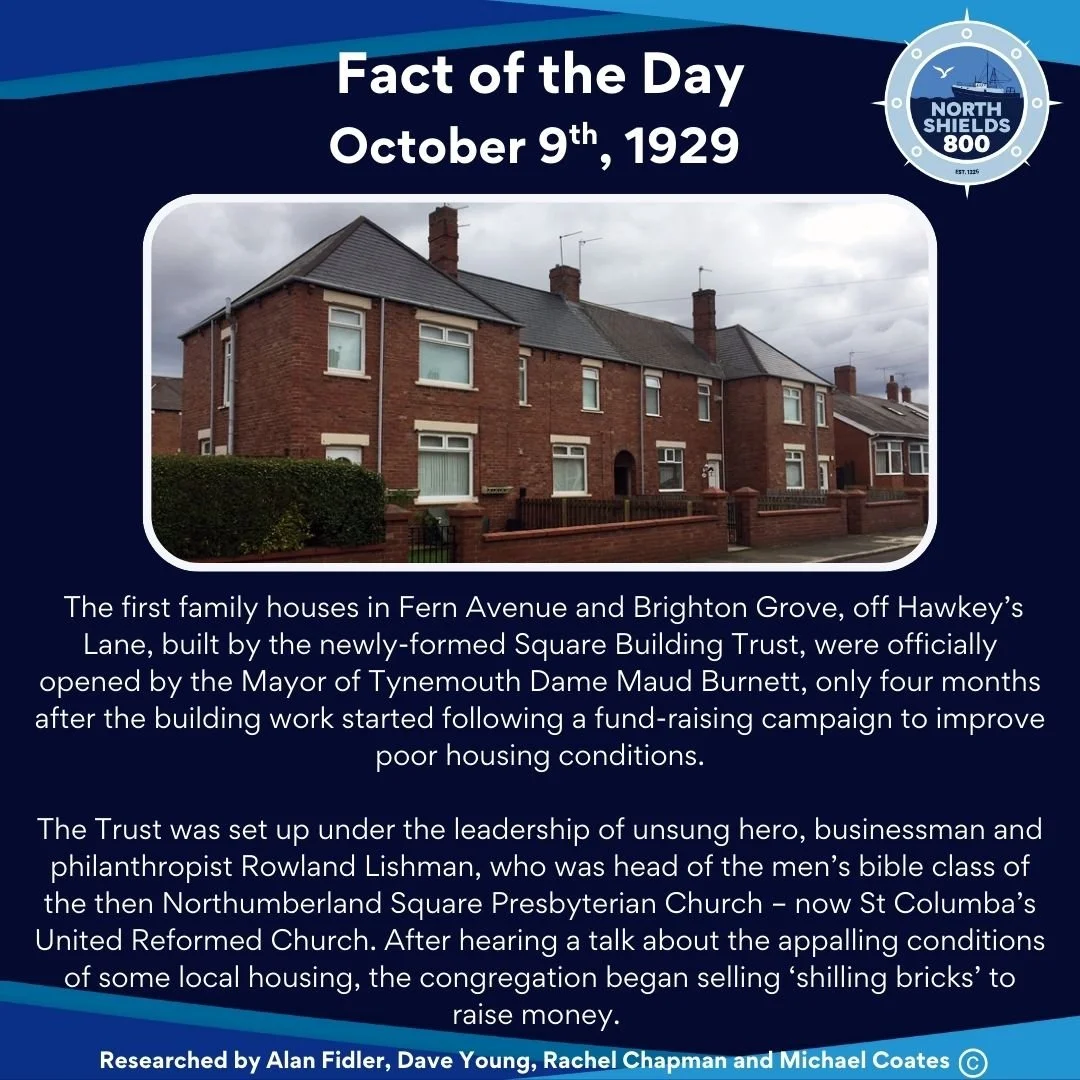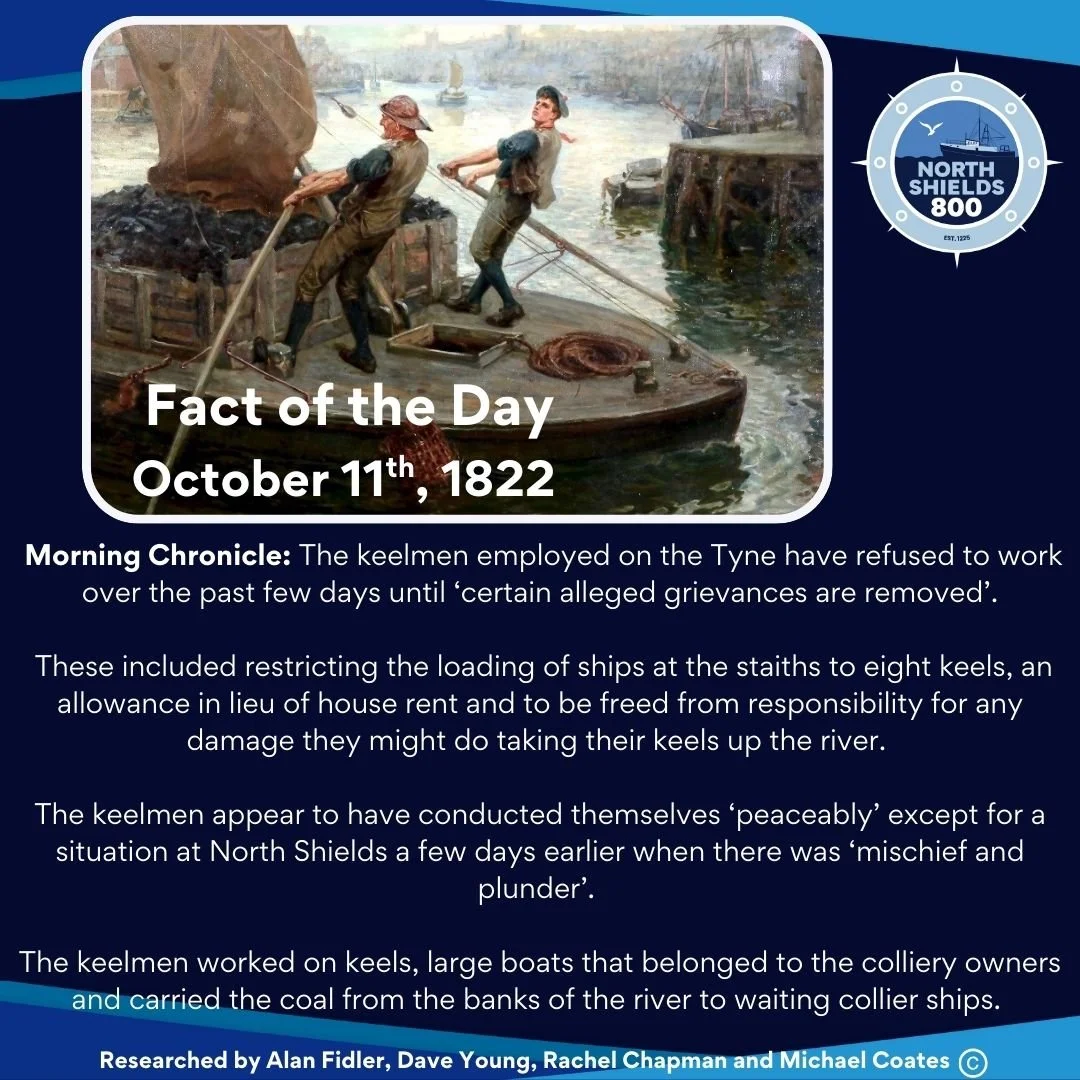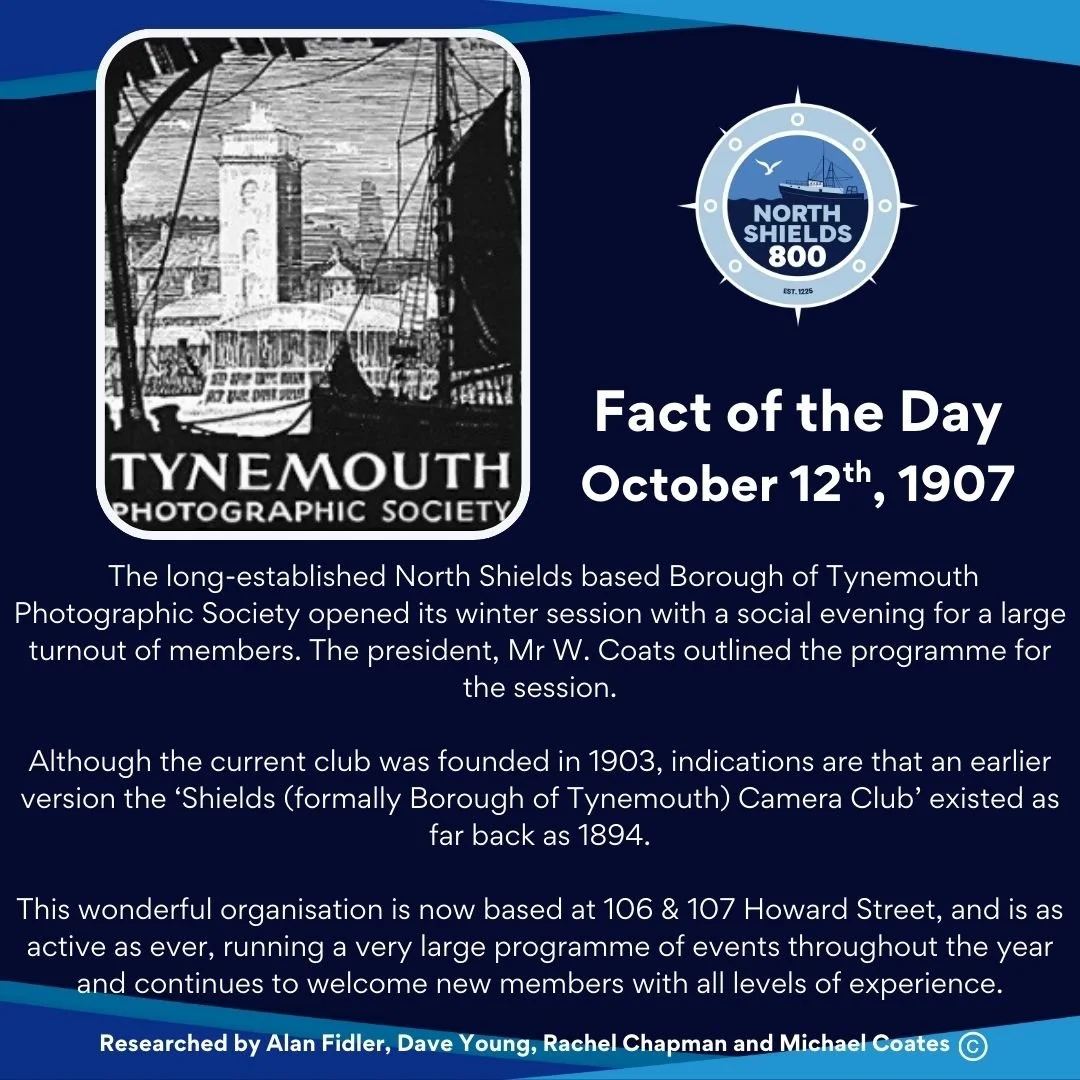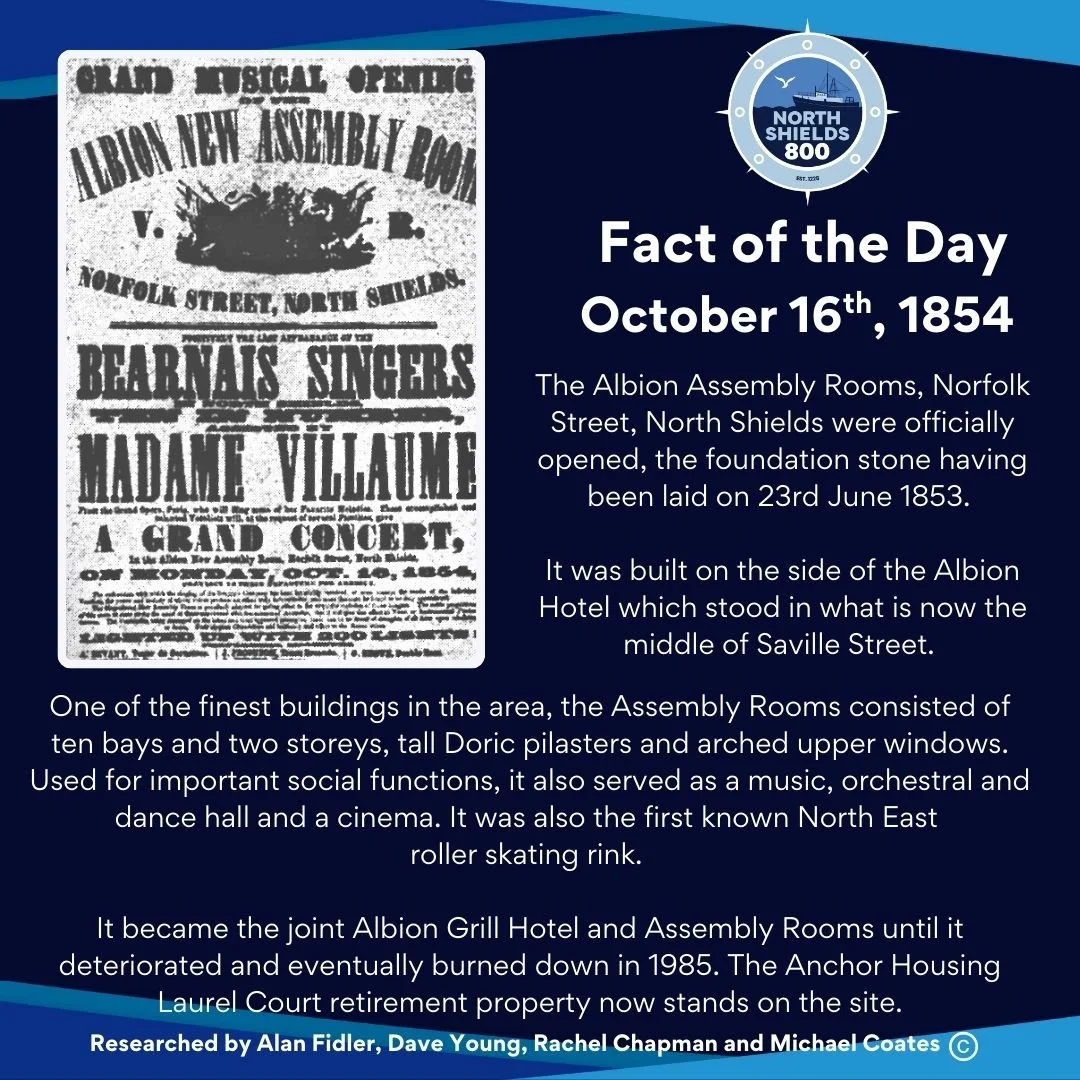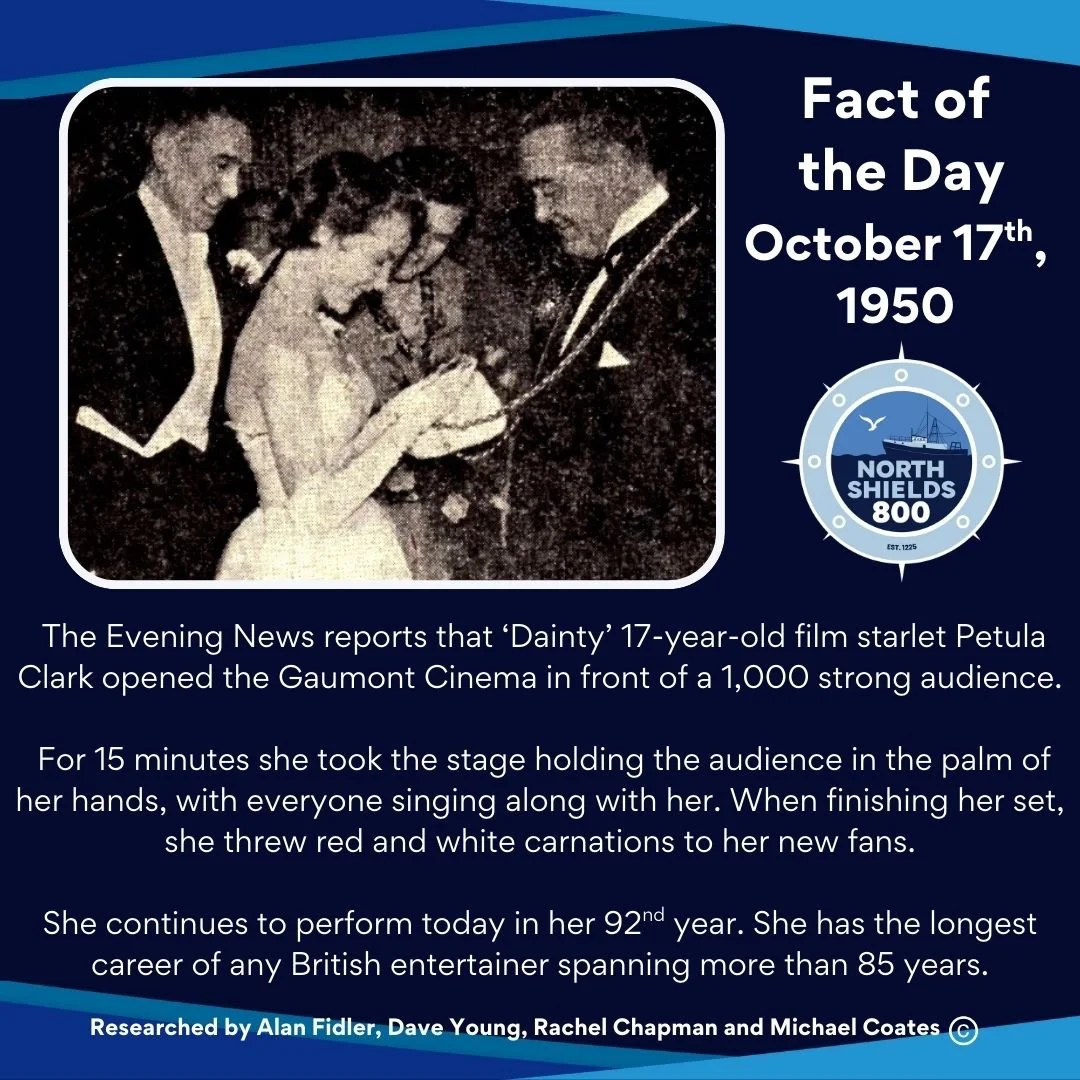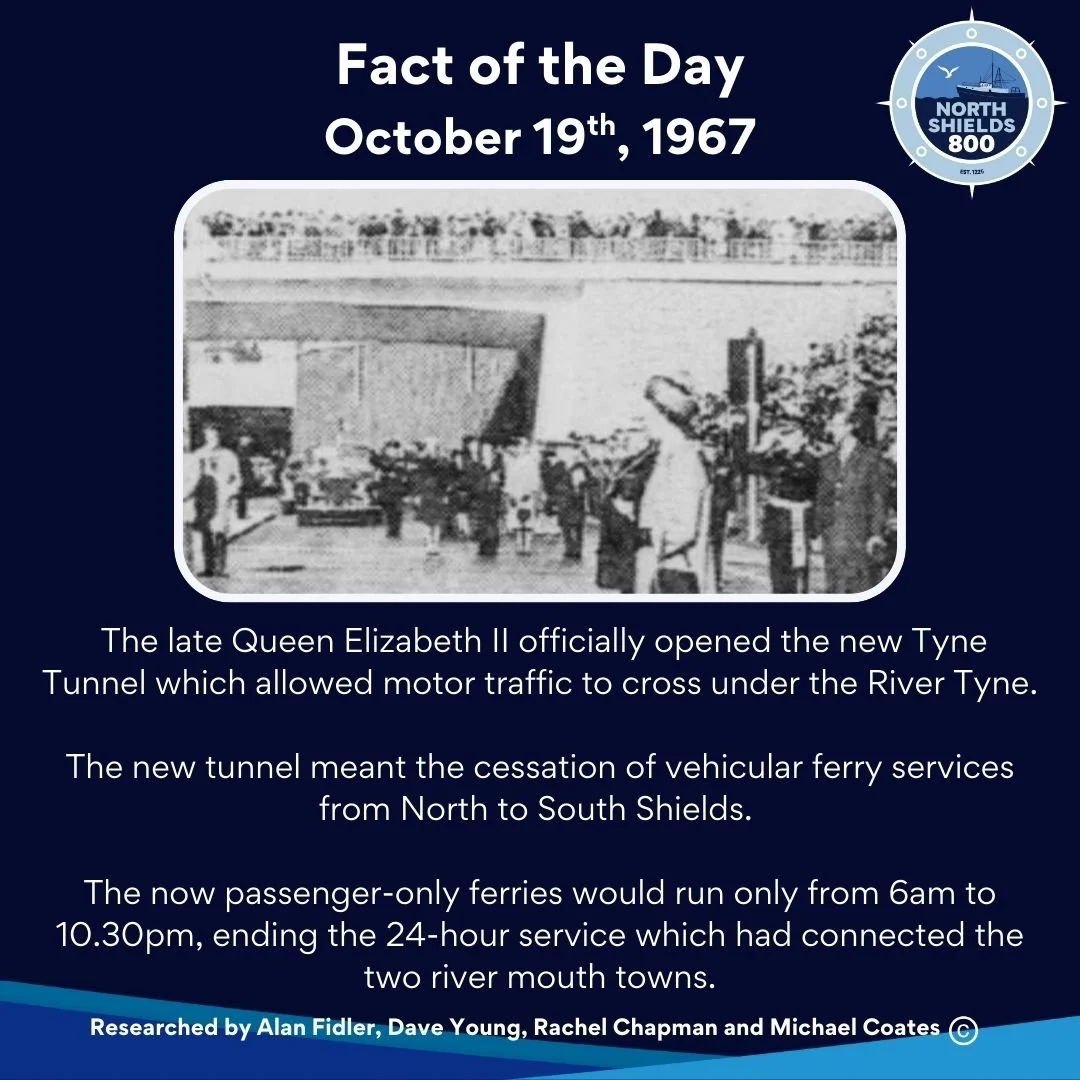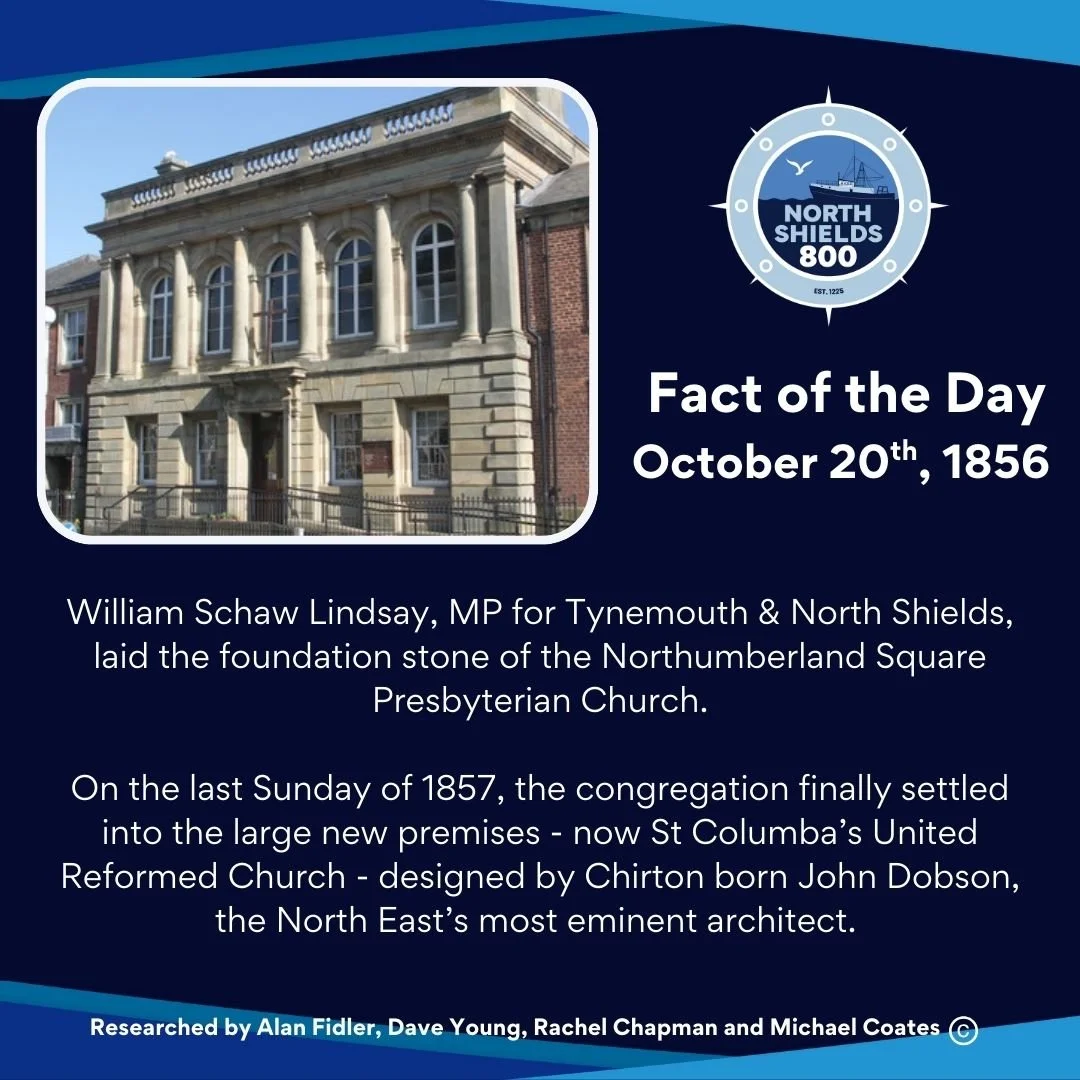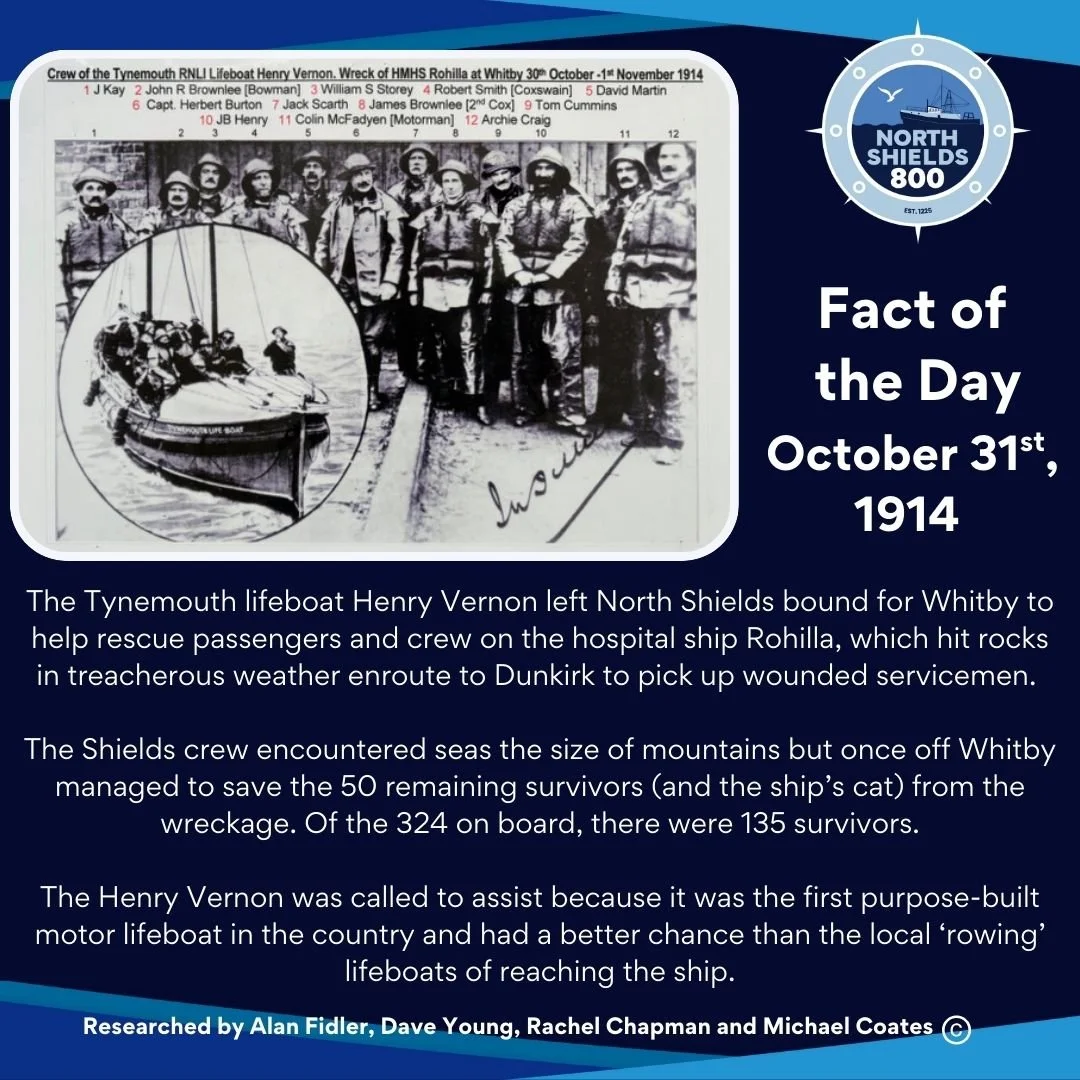Fact of the Day - October
All of October’s North Shields 800 Facts of the Day in one place.
October 1st, 1941
Overnight a German bombing raid caused the second highest loss of life and damage in the borough during the war.
There were 61 deaths and many injuries, with severe damage on Bedford Street, Saville Street and to the Queen Victoria School.
This was one of a number of raids from September 30th to October 2nd, with one falling on the corner of Bedford Street and Albion Road, damaging St Cuthbert’s Church, Presbytery, Schools and convent. A bomb also fell in the cemetery, severely damaging and disrupting graves.
October 2nd, 1868
A new division of the Order of the Sons of Temperance was opened in the Temperance Hall on Stephenson Street. The number of pubs in the town in the 19th century and its reputation for inebriation, meant it would have had no shortage of potential members.
The Sons of Temperance was originally a brotherhood of men who promoted the temperance movement and mutual support, starting in New York City in 1842, but quickly grew worldwide.
Before the establishment of the Temperance Church on Stephenson Street, members met at Broadbent Hall on King Street.
October 3rd, 1871
The Shields Daily News announced that General Tom Thumb and his wife would visit the Albion Assembly Rooms in Norfolk Street ‘to give two entertainments’.
Charles Sherwood Stratton (his real name) was an American entertainer and performer under circus pioneer Phineas T. Barnum.
At his birth he was of average size but grew to only 25” tall (63cms). He originally shot to fame in the 1840s, and was watched by 50 million people worldwide, becoming a favourite with both Queen Victoria and Abraham Lincoln.
Eventually he settled with his wife, Lavinia, in Massachusetts where he built a mansion complete with custom made furniture. He died suddenly at the age of 45 and more than 10,000 people travelled to see his body lying in state.
October 4th, 1884
The local media reported that Mr S B Siddall, proprietor of the New Princess Theatre in King Street, North Shields, provided a supper to employees who had helped with recent alterations to the building, after being granted an extension to stay open until 1am.
“Full justice having been done to the good things provided, the band in the orchestra performed a selection of dance music and dancing was freely indulged in.”
October 5th, 1793
A party of 295 French Catholic refugees landed at North Shields quay and were dispersed around the North of England to various sympathetic communities.
Three of the French priests undertook religious duties in the Milbourn Place chapel, which became a base for exiled French Catholic priests and laypeople who had been forced out of France by the French National Assembly in 1792.
Later, when Napoleon became master of France, the refugees were allowed to return to their own country. In June 1802, a number embarked on the ship Traveller at Shields and sailed for Cherbourg.
October 6th, 1852
At a meeting of the town council it was agreed that the Mayor of Tynemouth, Mr Alexander Bartleman, be requested ‘to convene a public meeting at an early day of merchants, ship-owners and other inhabitants of the Borough’ to consider the development of a sailors’ home.
This was to provide accommodation to the increasing number of seamen who were coming into the port due to increasing trade in the mid-19th century. Building work started in July 1854 and the Tyne Sailors’ Homes, on New Quay, were opened on Trafalgar Day (21 October) 1856.
Today, there is a blue plaque on the building in memory of a Swiss sailor A Kesseli who lived in the homes and who was lost at sea in 1914.
October 7th, 1811
The Royal Jubilee School opened its doors, with Nicholas Jowsey as the first headmaster. Although he welcomed both male and female pupils, they were educated separately. The girls on the top floor, supported by the ‘ladies of the town’, with the boys below.
Previously, there had been very little effort to educate poor people in North Shields. Some sectarian education was administered to a limited number of children as well as provision through the workhouse but nothing like that offered by this new school.
A prominent headmaster of this school, Thomas Haswell, known as ‘The Maister’ was honoured with a memorial on the junction of Albion Road and Preston Road, the site of the school.
October 8th, 1717
Trinity House minutes: The keeper of the Low Light complains he is denied access to the Fort by the military when he needs to check the flow of the tides and the sundial.
The significance is that the Low Light, which had become surrounded by Clifford’s Fort built as a coastal defence during the Dutch wars, was one of a pair of lights guiding ships through the treacherous mouth of the Tyne, so access was vital.
Trinity House complained again in 1725 about the lack of access to the sundial and river at Clifford’s Fort. This was compounded by the construction of the Governor’s House and officers’ quarters within the Fort, both obscuring the light.
Eventually, a new Low Light was in operation by 1810.
October 9th, 1929
The first family houses in Fern Avenue and Brighton Grove, off Hawkey’s Lane, built by the newly-formed Square Building Trust, were officially opened by the Mayor of Tynemouth Dame Maud Burnett, only four months after the building work started following a fund-raising campaign to improve poor housing conditions.
The Trust was set up under the leadership of unsung hero, businessman and philanthropist Rowland Lishman, who was head of the men’s bible class of the then Northumberland Square Presbyterian Church – now St Columba’s United Reformed Church.
After hearing a talk about the appalling conditions of some local housing, the congregation began selling ‘shilling bricks’ to raise money.
October 10th, 1894
John Foster Spence was awarded the Freedom of Tynemouth Borough for his lifelong devotion to the improvement of North Shields.
A prominent Quaker, he ran a successful drapery business in Howard Street and became closely involved in the religious, social and political life of the town. For six decades he served the community, including as a councillor, Mayor, alderman and magistrate and was an active member of more than 70 local committees.
He was a driving force behind the development of Tynemouth Volunteer Life Brigade and Northumberland Park.
October 11th, 1822
Morning Chronicle: The keelmen employed on the Tyne have refused to work over the past few days until ‘certain alleged grievances are removed’.
These included restricting the loading of ships at the staiths to eight keels, an allowance in lieu of house rent and to be freed from responsibility for any damage they might do taking their keels up the river.
The keelmen appear to have conducted themselves ‘peaceably’ except for a situation at North Shields a few days earlier when there was ‘mischief and plunder’.
The keelmen worked on keels, large boats that belonged to the colliery owners and carried the coal from the banks of the river to waiting collier ships.
October 12th, 1907
The long-established North Shields based Borough of Tynemouth Photographic Society opened its winter session with a social evening for a large turnout of members. The president, Mr W. Coats outlined the programme for the session.
Although the current club was founded in 1903, indications are that an earlier version the ‘Shields (formally Borough of Tynemouth) Camera Club’ existed as far back as 1894.
This wonderful organisation is now based at 106 & 107 Howard Street, and is as active as ever, running a very large programme of events throughout the year and continues to welcome new members with all levels of experience.
October 13th, 1891
During one of the most violent storms on record, the schooner Peggy ran into the Tyne for shelter, striking the Black Middens. Tynemouth Volunteer Life Brigade (TVLB) and HM Coastguards, using ‘breeches buoy equipment’ were involved in the rescue operation.
After four men were brought ashore, they realised there was still another man on board who had fallen and injured himself. Coastguard Hoare immediately volunteered to go out to the wreck in the breeches buoy and despite the horrendous weather, was able to grab the man by the collar so that he could be hauled to safety.
He was later awarded the Albert Medal and the Tynemouth Trust Gold Medal for his bravery.
The figurehead of the Peggy is on display in the TVLB Watch House and Museum at the Spanish Battery.
October 14th, 1819
There was a riot at New Quay, North Shields when the Mayor of Newcastle, Nicholas Reed, supported by troops, attempted to break the keelmen’s strike.
The troops killed the man who was inciting the mob. Reed sought refuge in the Northumberland Arms and was later rescued by the arrival of Dragoons from Newcastle.
October 15th, 1903
Shields Daily News: The Technical and Nautical School, Union Street advertises a course of six demonstrations in “American Parlour Cookery” to take place in the Lecture Room on this day at 7 o’clock”.
The same advertisement mentioned sailors’ cookery classes were held daily ‘in pursuance of the Newcastle Marine Committee’s recommendation’.
North Shields played a large part in improving the health of seafarers, specifically by improving their eating habits.
Miss Effie E. Bell. M.C.A. help found the Nautical School of Cookery, based in Union Street. She gave cookery classes to sailors to improve their diet so that they didn’t become subject to “dyspepsia and other evil effects of inferior cooking”, touring the country selling the idea to many of the leading ports including London, Liverpool and Cardiff.
October 16th, 1854
The Albion Assembly Rooms, Norfolk Street, North Shields were officially opened, the foundation stone having been laid on 23rd June 1853.
It was built on the side of the Albion Hotel which stood in what is now the middle of Saville Street (there was no through road to Stephenson Street/Charlotte Street at that time).
One of the finest buildings in the area, the Assembly Rooms consisted of ten bays and two storeys, tall Doric pilasters and arched upper windows. Used for important social functions, it also served as a music, orchestral and dance hall and a cinema. It was also the first known North East roller skating rink.
It became the joint Albion Grill Hotel and Assembly Rooms until it deteriorated and eventually burned down in 1985. The Anchor Housing Laurel Court retirement property now stands on the site.
October 17th, 1950
The Evening News reports that ‘Dainty’, 17-year-old film starlet Petula Clark, opened the Gaumont Cinema in front of a 1,000 strong audience.
For 15 minutes she took the stage holding the audience in the palm of her hands, with everyone singing along with her. When finishing her set, she threw red and white carnations to her new fans.
She continues to perform today in her 92nd year. She has the longest career of any British entertainer spanning more than 85 years.
October 18th, 1653
Following the compilation of ‘England’s Grievance Discovered’ by Chirton-based businessman Ralph Gardner, a Parliamentary committee recommends breaking the Newcastle monopoly over trade and exports from the lower Tyne estuary towns.
A final hearing is set for December 13th, but Oliver Cromwell dissolves the ‘Long Parliament’, frustrating the hearing of the committee’s report.
Newcastle will continue to exert ‘a malign influence’ over the trade and development of North and South Shields townships for a further 200 years until Parliament approves the creation of the River Tyne Commission, establishing an independent body to manage the river and its economy.
October 19th, 1967
The late Queen Elizabeth II officially opened the new Tyne Tunnel which allowed motor traffic to cross under the River Tyne.
The new tunnel meant the cessation of vehicular ferry services from North to South Shields. The now passenger-only ferries would run only from 6am to 10.30pm, ending the 24-hour service which had connected the two river mouth towns.
October 20th, 1856
William Schaw Lindsay, MP for Tynemouth & North Shields, laid the foundation stone of the Northumberland Square Presbyterian Church.
On the last Sunday of 1857, the congregation finally settled into the large new premises - now St Columba’s United Reformed Church - designed by Chirton born architect John Dobson, the North East’s most eminent architect.
October 21st, 1805
Vice-Admiral Cuthbert Collingwood led the British fleet into action at Trafalgar. His wife and daughters lived at his house in Chirton but he never resided there being almost constantly away on service at sea.
His monument at Tynemouth, was erected in1845, 40 years later, with guns from his ship HMS Royal Sovereign on the plinth.
Nelson said: “See how that noble fellow Collingwood takes his ships into action.”
October 22nd, 1958
A wooden dolly, depicting a fishwife with a basket, was unveiled in Northumberland Square, North Shields, where she stood as a centrepiece until 2022, when following repair after being vandalised, she took up residence in North Shields Library.
October 23rd, 1950
The Evening News reported that Miss Grace Colman officially opened the Tynemouth Labour Party’s Autumn Fayre at their headquarters in Alma Place, North Shields.
Grace Mary Colman was a British politician and a member of the Tynemouth Labour Party and Labour MP for Tynemouth from 1945 - 1950. Grace Colman taught at Ruskin College and the University of London. She was also an organiser for the Workers’ Educational Association.
She was a cousin of Academy Award winning actor Ronald Colman.
October 24th, 1982
North Shields Football Club entertained some top-notch visitors when Bobby Charlton’s All Stars played against Jackie Milburn’s North East Xl in a charity match at Appleby Park, attracting a crowd of 3,000.
Bobby Charlton’s team, including some members of the 1966 World Cup winning England squad, lost 5-6. The event raised funds for several causes, including Guide Dogs for the Blind.
Thanks to Trudi Thompson who researched the history of North Shields Football Club. Her book ‘Men from the North’, is on sale at the Old Low Light Heritage Centre.
October 25th, 1878
Alexander Anderson, the newly appointed Superintendent of the County Borough of Tynemouth Police, the most senior officer in the force, reported on the previous 12 months.
The police had dealt with 914 persons for offences of drunkenness and disorderly conduct. [Whilst this might seem excessive by present day standards the figure was only half of what it had been in 1873].
The report also noted that 158 known thieves, 157 vagrants, 301 prostitutes and 682 habitual drunkards had been dealt with by the police.
Taken from History of Tynemouth Borough Police written in 1969.
October 26th, 2015
The Tynemouth World War One Garden and Memorial, listing more than 1800 local men lost in the war - 1914-21 - was opened at the Linskill Community Centre.
Unique in the UK, the memorial lists the casualties by their home address at the time of the war. In larger towns and cities, named war memorials were not created in the post-war period due to uncertainty that all the men and women lost would be accounted for, as there were no accurate or official records existing at the time.
October 27th, 1861
Walter Shewell Corder, a Quaker, was born in Sunderland. He moved to North Shields in 1885 and, by 1887, was running two pharmaceutical businesses in the town.
He soon realised the possibilities of treating fish processing waste and founded the North Shields Guano Works at the Low Lights on the fish quay. The smell from the works was appalling and on September 4th, 1895, the Shields Daily News reported that Mr Corder, a JP, had received a summons for having ‘caused a nuisance to exit from his premises’.
Residents were called to give accounts of the effects the stench was having on them and Mr Corder was given three months to abate the nuisance. The smell from the works continued to cause problems well into the 1960s.
October 28th, 1843
Newcastle Journal reports ‘a large concourse of people’ gathered to watch the safe return of the whaler The Lady Jane from the Davis Straits as she approached the harbour.
The journey home had taken just four weeks after a ‘remarkably fine passage’ and all the crew were well. She had ‘nine fish (whales) and 60 tuns of oil’.
October 29th, 1914
North Shields born Lt James Leach wins the Victoria Cross near Festubert in Flanders during the First Battle of Ypres at the beginning of the First World War.
During the fierce battle, Leach, aged 22, with another soldier, took it upon themselves to retake a trench that had been captured.
The presentation ceremony took place on January 13th, 1915 by King George V at Buckingham Palace.
October 30th, 1942
Thomas (Tommy) Brown helped in the recovery of German Enigma code books from a U-boat sunk by HMS Petard. Two other men were lost in the recovery of the precious code books that would help Bletchley Park to break the German naval code.
Brown, a civilian member of the crew, was awarded the George Medal which was a closely guarded secret until the end of the war. Sadly, Tommy died in a fire at his home on the Ridges estate (now the Meadow Well) in March 1945.
His heroism is remembered in a stained-glass window and room at the Saville Exchange, Howard Street and the newly created Town Square in Bedford Street is named after him.
October 31st, 1914
The Tynemouth lifeboat Henry Vernon left North Shields bound for Whitby to help rescue passengers and crew on the hospital ship Rohilla, which hit rocks in treacherous weather enroute to Dunkirk to pick up wounded servicemen.
The Shields crew encountered seas the size of mountains but once off Whitby managed to save the 50 remaining survivors (and the ship’s cat) from the wreckage. Of the 324 on board, there were 135 survivors.
The Henry Vernon was called to assist because it was the first purpose-built motor lifeboat in the country and had a better chance than the local ‘rowing’ lifeboats of reaching the ship.



